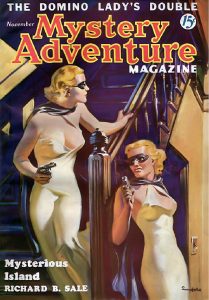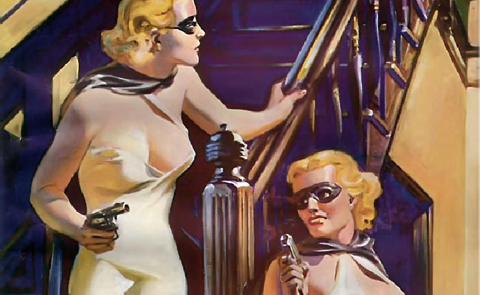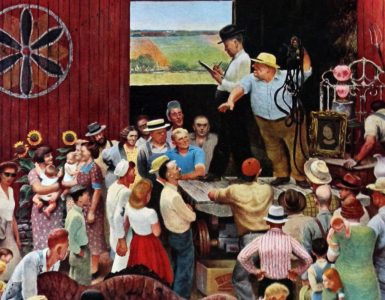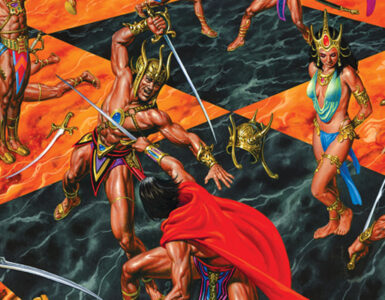 In the violence-riddled cities of the pulp era, the police were either unable or unwilling to deal with the criminal element. It was left to strong-willed and often well-to-do citizens to take matters into their own hands. Over time, these characters became known as the pulp heroes. The Shadow, Doc Savage, The Spider, The Green Lama, The Avenger, The Black Bat, and others. Helping these heroic vigilantes were their hand-picked agents, including a number of female assistants.
In the violence-riddled cities of the pulp era, the police were either unable or unwilling to deal with the criminal element. It was left to strong-willed and often well-to-do citizens to take matters into their own hands. Over time, these characters became known as the pulp heroes. The Shadow, Doc Savage, The Spider, The Green Lama, The Avenger, The Black Bat, and others. Helping these heroic vigilantes were their hand-picked agents, including a number of female assistants.
The Shadow had his Myra Reldon and Margo Lane; Nita Van Sloan worked next to The Spider; although disgruntled, Doc Savage accepted the assistance of his cousin Pat, while The Avenger was capably helped by Nellie Grey and Rosabel Newton. And then there’s The Domino Lady . . . .
The only female pulp hero to be featured in her own series, The Domino Lady appeared in six stories credited to Lars Anderson. Published in 1936, five of her tales ran in SAUCY ROMANTIC ADVENTURES. The character’s final tale appeared in MYSTERY ADVENTURE MAGAZINE.
The Domino Lady is really debutante Ellen Patrick. Following the murder of her father — an honest and tireless district attorney — Ellen decides to fight evil in society. Wearing a small, dark mask and a tight and revealing evening gown, she becomes The Domino Lady. Armed with an automatic pistol and a knockout drug, she robs her victims, donating the bulk of the loot to charity and leaving her calling card.
In his introduction to Vanguard Publications’ DOMINO LADY: THE COMPLETE COLLECTION, Bernard Drew writes:
“You’re in for a treat as you read these half-dozen Domino Lady escapades, for that’s the best way to describe them. Escapades. They involve no investigation, no probing, no crime solving. Ellen has already zeroed in on the bad guy by story’s start. The main plot element, in fact, is the shapely heroine wrangling her way into a social situation, making light conversation, swiping something or other of value from someone who deserves to lose it and dropping a calling card which reads ‘The Domino Lady’s Compliments.'”
Over the last few decades, new adventures of The Domino Lady have been published by various small and independent presses. Moonstone Books has released a number of books and comics featuring the character. Airship 27 has issued a pair of anthologies collecting new Domino Lady stories. Perhaps the strangest versions are the erotic comic book tales written and drawn by the late Ron Wilber.
At 11:35 PM on Thursday, July 27, please join Michelle Nolan in the PulpFest 2017 programming room for “Compliments of The Domino Lady,” a brief discussion of what The Domino Lady means in pulp history and how the character paved the way for dozens of costumed heroines in the comics of the Golden Age and beyond. It’s all part of the convention’s celebration of the dangerous dames of the pulps, the hardboiled ladies who helped to pave the way for such modern day gumshoes as Sue Grafton‘s Kinsey Millhone, Marcia Muller‘s Sharon McCone, and Sara Paretsky‘s V. I. Warshawski. Collectively, these authors and their characters have helped detective fiction to evolve in new directions.
A mainstream journalist for more than fifty years, Michelle Nolan has also covered the history of genre fiction in pulps, comics, books and films in more than 1,000 magazine, newspaper and book articles. She is the author of the definitive “LOVE ON THE RACKS: A HISTORY OF AMERICAN ROMANCE COMICS and BALL TALES: A STUDY IN AMERICAN SPORTS FICTION. In 2014, Michelle received an Inkpot Award from Comic-Con International: San Diego.
(Although the first costumed pulp heroine appeared in just six stories in rare and obscure mid-1930s pulps, The Domino Lady commanded three covers for those magazines. All three were painted by Norman Saunders, one of the leading artists and illustrators of the pulp era. During a career that spanned five decades, Saunders completed over 2500 commercial art assignments, including more than one thousand covers featured on 85 different pulp titles.
In addition to his work for the pulp industry, Norman Saunders illustrated for national advertisers, slick magazines, paperbacks, men’s adventure magazines, calendars, comic books, trading cards, and more. He died in 1989 at the age of 82.)







